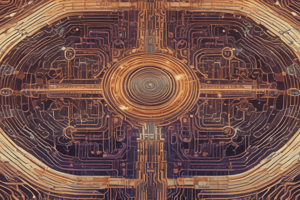Podcast
Questions and Answers
What does the inductor filter do to the output of the rectifier?
What does the inductor filter do to the output of the rectifier?
blocks AC component and allows DC Current to pass through the load
Capacitor filter is used for _____ loads and connected directly across the load.
Capacitor filter is used for _____ loads and connected directly across the load.
light
What is the advantage of inductor filter?
What is the advantage of inductor filter?
- Suitable for low load resistance and high current applications (correct)
- Blocks DC Current
- Has high ripple
- Consumes less power
The output of the capacitor filter allows both AC and DC components to pass through.
The output of the capacitor filter allows both AC and DC components to pass through.
What is the purpose of a Zener diode?
What is the purpose of a Zener diode?
Match the subsystems/components of a Cathode Ray Oscilloscope (CRO) with their descriptions:
Match the subsystems/components of a Cathode Ray Oscilloscope (CRO) with their descriptions:
Which breakdown occurs in heavily doped diodes and involves a small depletion region?
Which breakdown occurs in heavily doped diodes and involves a small depletion region?
The operation of a Zener Diode in reverse bias is to maintain ________.
The operation of a Zener Diode in reverse bias is to maintain ________.
A Full wave rectifier uses both half cycles of the input AC signal.
A Full wave rectifier uses both half cycles of the input AC signal.
What is used to convert bidirectional AC to unidirectional voltage?
What is used to convert bidirectional AC to unidirectional voltage?
Flashcards are hidden until you start studying
Study Notes
PN Junction Diode
- A PN junction diode is formed by combining p-type and n-type regions.
- Due to doping, electrons are present in the n-region, and holes are present in the p-region.
- When p and n regions are joined, electrons and holes diffuse, and ions are formed.
- The depletion layer, also known as the barrier potential or built-in potential, contains thermally generated ions.
- The built-in potential values for silicon and germanium are 0.6-0.7V and 0.3V, respectively.
Forward and Reverse Bias
- In forward bias, electrons from the n-type region move towards the p-type region, and holes from the p-type region move towards the n-type region.
- The barrier potential is reduced, allowing current to flow.
- In reverse bias, electrons from the n-type region move away from the junction, and holes from the p-type region move away from the junction.
- The depletion layer widens, and current is low.
PN Junction Diode Characteristics
- The forward voltage at which the diode starts allowing large electric current is called the cut-in voltage or knee voltage.
- The cut-in voltage for silicon and germanium diodes are approximately 0.7V and 0.3V, respectively.
- The dynamic resistance of a diode is the ratio of the small change in voltage to the resulting change in current.
Applications of PN Junction Diode
- Rectifiers in DC power supplies
- Switch in digital logic circuits
- Clipping circuits
- Demodulation circuits
- Detectors in optical communication circuits
Zener Diode
- A zener diode is a type of diode that permits current to flow in both forward and reverse directions.
- The zener diode is normally operated in reverse breakdown, and the current direction is from anode to cathode.
- Zener diodes are highly doped diodes.
- The breakdown voltage is known as the "Zener knee voltage" or "Zener voltage."
Zener Diode Characteristics
- The forward characteristics of a zener diode are similar to those of an ordinary forward-biased junction diode.
- In reverse direction, there is a very small leakage current between 0V and the Zener voltage.
- When the voltage reaches the breakdown voltage, the current flow is dramatic.
Operation of Zener Diode
- In forward bias, the operation is similar to that of an ordinary PN junction diode.
- In reverse bias, the breakdown depends on the amount of doping.
- There are two types of breakdowns: Zener breakdown and avalanche breakdown.
Breakdowns
- Zener breakdown occurs in heavily doped diodes, with a smaller depletion region and lower breakdown voltage.
- Avalanche breakdown occurs in lightly doped diodes, with a larger depletion region and higher breakdown voltage.
Applications of Zener Diode
- Zener regulators
- Zener comparators
- Zener limiters
- Zener in power supplies
Zener Diode Regulator
- A zener diode is always operated in its reverse-biased condition.
- The voltage regulator circuit can be designed using a zener diode to maintain a constant DC output voltage.
- The output voltage is selected to be the same as the breakdown voltage of the diode.
Basic Building Block of LMPS
- Transformer: inputs AC voltage at a required voltage level.
- Rectifier: converts AC to pulsating DC.
- Filter: used to get a pure DC voltage.
- Regulator: gives a steady DC output independent of load variations and input supply fluctuations.
Rectifiers
- Electronic devices used for converting AC voltage into unidirectional voltage.
- Types of rectifiers: half-wave rectifier, full-wave rectifier.
Half-Wave Rectifier
- Operation:
- During the positive half cycle, the diode is forward-biased, and current flows through the load resistor.
- During the negative half cycle, the diode is reverse-biased, and there is no current flow through the load resistor.
Full-Wave Rectifier
- A center-tapped full-wave rectifier uses a center-tapped transformer and two diodes to convert the complete AC signal into a DC signal.
- Operation:
- During the positive half cycle, D1 is forward-biased, and D2 is reverse-biased.
- During the negative half cycle, D2 is forward-biased, and D1 is reverse-biased.
Filters
- Used to minimize the undesirable AC component in the output of a rectifier.
- Types of filters: inductor filter, capacitor filter, LC filter, and CLC filter.
Inductor Filter
- When the output of the rectifier passes through the inductor filter, it blocks the AC component and allows the DC component to pass through the load.
- The output of the filter can be analyzed using Fourier series.
Capacitor Filter
- Used for light loads and connected directly across the load.
- The capacitor filter takes in the ripple and shorts it to the ground, while the DC component appears at the load.
CRO (Cathode Ray Oscilloscope)
- Gives a visual representation of time-varying signals.
- Used as an electronic test equipment in laboratories.
- The CRO plays an important role in electronic circuits.
Block Diagram of CRO
- Major subsystems: cathode ray tube (CRT), vertical amplifier, horizontal amplifier, sweep generator, and power supplies.
Applications of CRO
- Voltage measurement
- Measurement of phase
- Measurement of frequency
- Display of different types of waveforms
- Measurement of short time intervals
- Used in voltmeter to measure potential difference
Studying That Suits You
Use AI to generate personalized quizzes and flashcards to suit your learning preferences.





